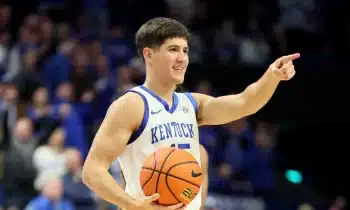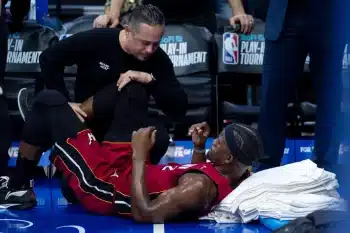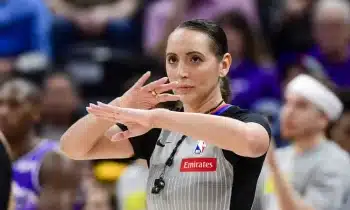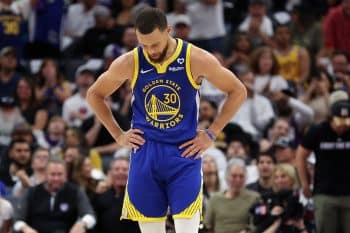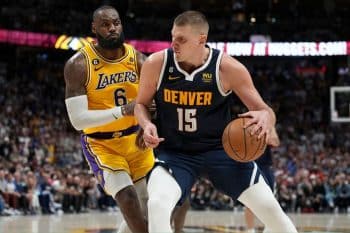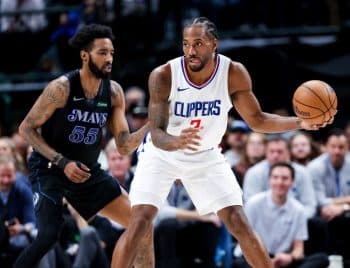NBA
NBA Daily: The Boston Celtics’ Interesting Dilemma

The Boston Celtics’ 2017-18 season was a success by all accounts. They fell one win shy of advancing to the NBA Finals and did so without two of their best players – Kyrie Irving and Gordon Hayward. At first glance, the 2018 iteration of the Celtics is even more intriguing. The Celtics return both aforementioned stars, with two other young pillars – Jayson Tatum and Jaylen Brown – on the precipice of stardom, too. Additionally, the Eastern Conference championship is almost certainly up for grabs with LeBron James heading west to Los Angeles, concurrently eliminating Cleveland from contention. But think twice before penciling the Celtics into the NBA Finals. There are questions to be answered about the Celtics’ future, as well as concerns about the season at hand.
The most pressing item to be addressed is the team’s chemistry and rotation. Celtics head coach Brad Stevens must delicately manage his roster. He will likely rely heavily on Irving and Hayward considering both are proven All-Stars. And considering both will be working back from a knee procedure and a gruesome leg injury, respectively, there will likely be minutes restrictions in place that allow for the younger Celtics to continue contributing early on this season. However, what effect might lesser roles have on the likes of Terry Rozier, Brown and/or Tatum as the season wears on?
Rozier, Brown and Tatum flourished while averaging 36.6, 32.4, and 35.9 minutes per game, respectively, in the 2018 postseason. Basketball is a rhythm game and few players can find theirs without a requisite amount of playing time. That could hinder their progress, and potentially hinder production. Further, will splitting minutes with the younger Celtic wings prove to be counterproductive to Hayward, who averaged 34.5 minutes per game in the 2016-17 season with Utah – his last complete season prior to the injury? Similarly, will Kyrie’s effectiveness dwindle due to a dip in playing time from his pre-injury 32.2 minutes per game last season?
Less direct implications are also possible. Marcus Smart will likely see a decreased role due to the talent stockpiled on the roster, but Smart’s contributions last season were noteworthy. He is an ultra-versatile defender who can guard four positions. While he is limited offensively, his hustle and grit are contagious. Limiting his minutes might be a necessity, but his energy is difficult to replace. Having too much talent is rarely a detriment, but all of Brown, Tatum, Hayward, Smart, Rozier, and Irving can’t be maximized. Long-term, this is much more of a problem for general manager Danny Ainge than it is for the team (or even coach Stevens), but it is a problem nonetheless. Maybe Ainge packages two of the above players for Jimmy Butler, or another superstar before the deadline; but barring a similar move, maximizing all of the talent on the roster will be challenging.
And then there are the challenges that await the Boston Celtics outside of their locker room – most notably, the development of Toronto Raptors and Philadelphia 76ers. Both of the Celtics’ divisional rivals stand to improve in 2018. The Raptors took a chance in trading for disgruntled Spurs star Kawhi Leonard. While he very well may leave Toronto after the 2018-19 season, Leonard is a definitively better talent than DeMar DeRozan on both sides of the ball. Canada’s only NBA franchise also took on Danny Green in the DeRozan-Leonard transaction. Green is a career 39.5 percent three-point shooter who can still defend at a high level. Add Leonard and Green to the Raptors’ existing foundation of Kyle Lowry, OG Anunoby, Jonas Valanciunas, Serge Ibaka, and C.J. Miles and you have a contender in the making. What’s more, the arrival of Leonard and Green does more than simply infuse talent; they represent players who came up big in key moments throughout their respective careers (e.g., in the 2014 NBA Finals, Leonard was named the Finals MVP and Green shot 45 percent from three-point range over the course of the five-game series). The addition of the two former Spurs should improve on the Raptors’ poor execution in recent trips to the Playoffs. While the trade represents a major risk on behalf of Raptors’ President Masai Ujiri and the franchise, it could just as easily pay off with one or more NBA Finals appearances.
Comparatively, Philadelphia had a relatively quiet offseason. They traded the twelfth overall pick, Mikal Bridges, to the Phoenix Suns for Zhaire Smith, who, in typical Sixers fashion, injured his foot in summer league and will miss at least the beginning of the 2018 season. The team also re-signed J.J. Redick, and traded for Wilson Chandler. But most of the improvement that Philadelphia stands to undergo will come from standing pat, as their core is relatively young. Currently, Joel Embiid is 24, Ben Simmons is 22, and Markelle Fultz is only 20 – and all reports indicate he has successfully worked through his shoulder injury and subsequent shooting hitch. The infusion of a productive Fultz alone should add a few wins; for comparison’s sake, Lonzo Ball, who was selected immediately after Fultz in the 2017 NBA Draft, posted a win share of two last season. Philadelphia will ask less of Fultz than was asked of Ball by the Lakers, but a similar net effect is reasonable given Ball’s ups and downs in 2017-18. And that doesn’t take into consideration the progress that can be expected from Simmons and Embiid.
The Sixers represent less of an immediate threat to the Celtics than the Raptors, having lost to Boston in the second round of the 2018 Playoffs 4-1; but they pose a very real threat beyond 2018-19. Entering 2019-20, they should have only around $70 million in salary commitments, assuming all team options are picked up. The majority of that money is spread between the core of Embiid, Simmons, Fultz, Robert Covington, Dario Saric and Zhaire Smith – a formidable six-man rotation. The team will have approximately enough money to sign one free agent to a max deal. Philly’s core is young and talented, and they can add a superstar to it to improve even more quickly for next season and beyond – a scary concept to anyone building an NBA franchise.
If all of that doesn’t worry Ainge, Stevens, and the Boston faithful, there are the rumors about Irving’s desire to team up with Jimmy Butler and/or flee to New York. Rumors are anecdotal at best, but this particular rumor is more substantive than most. Irving’s hometown Knicks were on a short list of preferred landing spots, communicated by the point guard to the Cavs last summer. Further, rumblings have permeated the mainstream media about Irving and Butler’s desire to play together next season. Butler was recently quoted by Joe Cowley of the Chicago Sun-Times in a recent interview saying he has grown sick of “the nonchalant attitude of his younger teammates, specifically Karl-Anthony Towns.” While any number of scenarios can play out in Minnesota, it is unlikely that ownership approves of a deal in which Towns is moved. Therefore, odds of a continued working relationship between Butler and Minnesota appear unlikely. And Irving’s unwillingness to sign an extension, while expected given the current salary cap environment, opens the door to suitors next July, which will likely result in the two players looking at signing with the same team a la LeBron James and Dwyane Wade circa 2010.
None of these scenarios by themselves spell disaster for the Celtics, but the sum of the parts certainly causes more anxiety for the Boston front office than each issue would individually. The Boston Celtics’ rebuild, which began immediately after the 2012-13 season via the Kevin Garnett and Paul Pierce trade, took hold quickly. The 2017-18 season is the culmination of that rebuild, with steady progress between the two points in time. Traditionally, perennial contenders like the current Golden State Warriors, 2000’s Lakers and 1990’s Bulls enjoy years of success after struggling to build a team and overthrow an antagonist. Nothing is promised in the NBA, but the path to success for the Celtics, which appeared seamless to many, has cracks in its armor. The Celtics could end the 2018-19 season as Eastern Conference champions facing off against whoever wins the West; but they could just as easily be eliminated in the Eastern Conference Semifinals, lose Irving to free agency and have two formidable opponents in their division to contend with for the foreseeable future. Neither scenario is overtly bad, but from the potential chemistry issues to the intra-division competition, to the potential to lose their best player, the Celtics’ future is far less certain than it appears at first glance.
